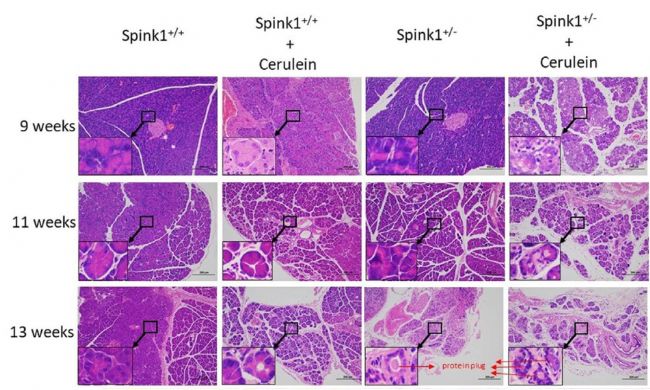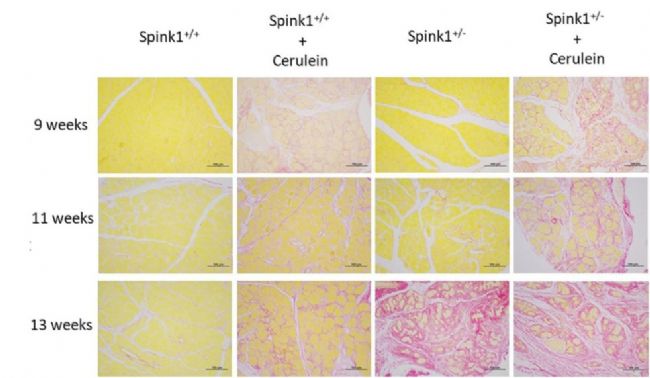Professor Li Zhaoshen, director of the Shanghai Pancreatic Disease Research Institute, and associate professors of the Department of Gastroenterology, Changhai Hospital, Second Military Medical University, published an article in the journal Gut, reporting their newly developed mouse model of chronic pancreatitis. The new model The SPINK1 c.194+2T>C mutation phenotype commonly used in Chinese patients is the target, which can truly reflect the clinical pattern of chronic pancreatitis in vivo.
Previously, Boston University's Eszter Hegyi and Miklós Sahin-Tóth reported that their team created a CPA1 mutant knock-in mouse model that carries the human CAP1 p.N256K mutation at the Cap1 locus. CPA1 mutations lead to carboxypeptidase A1 misfolding and endoplasmic reticulum stress-related chronic pancreatitis.
Chinese scholars have found that SPINK1 (Kazal-type serine protease inhibitor 1) c.194+2T>C gene mutation is the most common in Chinese patients with idiopathic chronic pancreatitis. Through in vitro studies, the pathogenesis of c.194+2T>C variants acting on chronic pancreatitis has been described as a lack of secretion of serine protease inhibitors.
However, this mechanism observation has been lacking in the SPINK1 c.194+2T>C animal model. The only in vivo study evidence to date comes from the homozygous Spink1 (also known as Spink3) phenotype, but this leads to the birth of the mouse model. He died of autophagic acinar cell death within 15 minutes.
Considering that more than 80% of Chinese patients carry SPINK1 c.194+2T>C heterozygous mutations, the researchers believe that a heterozygous c.194+2T>C animal model can actually better delineate the clinical manifestations of chronic pancreatitis. mode.
The mouse c.194+2T>C mutation was introduced by the CRISPR/Cas genome editing tool and was commissioned by Cyagen Biosciences . The mutant mouse was named Spink1−/− or Spink1+/−, but Spink1− /− The mice died shortly after birth, which is consistent with previous studies. Spink1+/− and Spink1+/+ mice were randomly divided into 4 groups after 7 weeks of birth (guaranteed 3 small per sample point per group) mouse).
Anatomically observed, both Spink1+/+ and Spink1+/− mice treated with cerulein showed acinar atrophy and inflammatory cell infiltration at 9 weeks of age (Fig. 1). Notably, Spink1+/- mice treated with cerulein developed acinar to ductal cell metaplasia (ADM), pancreatic fibrosis, and stellate cell activation at 9 weeks of age, and these pathological changes were further at 11 weeks and 13 weeks of age. development of. Spink1+/− mice that were not treated showed mild acinar loss at 11 weeks of age, and 1 mouse developed pancreatic fibrosis, stellate cell activation, and ADM at 13 weeks of age, and, whether or not treated, Spink1+/ − There is a protein plug in the mouse. The heterozygous Spink1 c.194+2T>C mutant animal model developed partially chronic pancreatitis, the youngest formed at 13 weeks of age.

Figure 1: Effect of heterozygous Spink1 c.194+2T>C mutation on mouse pancreas (closed arrow indicates protein plug formation)
This result confirmed the pathogenicity of the heterozygous Spink1 c.194+2T>C mutation in vivo. It was first discovered that this mutation can directly lead to chronic pancreatitis without any cofactor, suggesting that chronic pancreatitis may be a single gene. disease.

Figure 2: Pancreatic tissue fibrosis in heterozygous Spink1 c.194+2T>C mutant mice, whether or not treated with cerulein
Despite this, the researchers noted that not all mice developed typical chronic pancreatitis at 13 weeks of age, with some showing only acinar cell atrophy and moderate ADM. The reason for this may be that the heterozygous Spink1 c.194+2T>C mutation is partially exposed and the observation time is insufficient. However, as a further exploration of the pathogenesis and potential therapeutic targets of chronic pancreatitis, heterozygous Spink1 c.194+2T>C mutant mice are still an ideal model. And the presence of protein plugs suggests that this mouse model may also be a new model for pancreatic calcification in chronic pancreatitis.
Finally, the researchers concluded that Spink1+/+ mice derived from Spink1+/- mice and C57BL/6 mice have normal pancreatic histology, suggesting that patients with heterozygous Spink1 mutations can produce healthy offspring, which is also Prenatal screening of patients provides the basis.
Original search: Heterozygous Spink1 c.194+2T>C mutant mice spontaneously develop chronic pancreatitis
Fluorine-Containing Phenylamine
Most of the Fluorine-Containing Phenylamine products are a light yellow oily liquid, relatively high density, insoluble in water. Most of them are used in the manufacturing of pesticides and dye intermediates, small part of them can be used as an analytical reagent. The steam or smoke of fluorine-containing phenylamine series is irritated to eyes, mucous membranes and upper respiratory. Vapor and air can form explosive mixtures, in case of fire, high-heat combustion caused the explosion. And oxidant may react. Decomposition by high fever and emit toxic gases. In case of high fever, increased pressure within containers, cracking and the risk of explosion. Protective measures must be done carefully during product storage. Once the fire occurred, it must be immediately evacuated from air leakage,personnel to a safe area, prohibit access to the contaminated area. Recommended emergency personnel wearing self-contained breathing apparatus and wear chemical protective clothing. In the ambulance personnel to ensure proper safety measures, immediately use foam, carbon dioxide, dry, sandy soil to put out a fire.
Containing Phenylamine,2-Bromo-4-Methoxy-Phenylamine,5-Fluoro-2-Iodoaniline
Taizhou Volsen Chemical Co., Ltd. , https://www.volsenchem.com